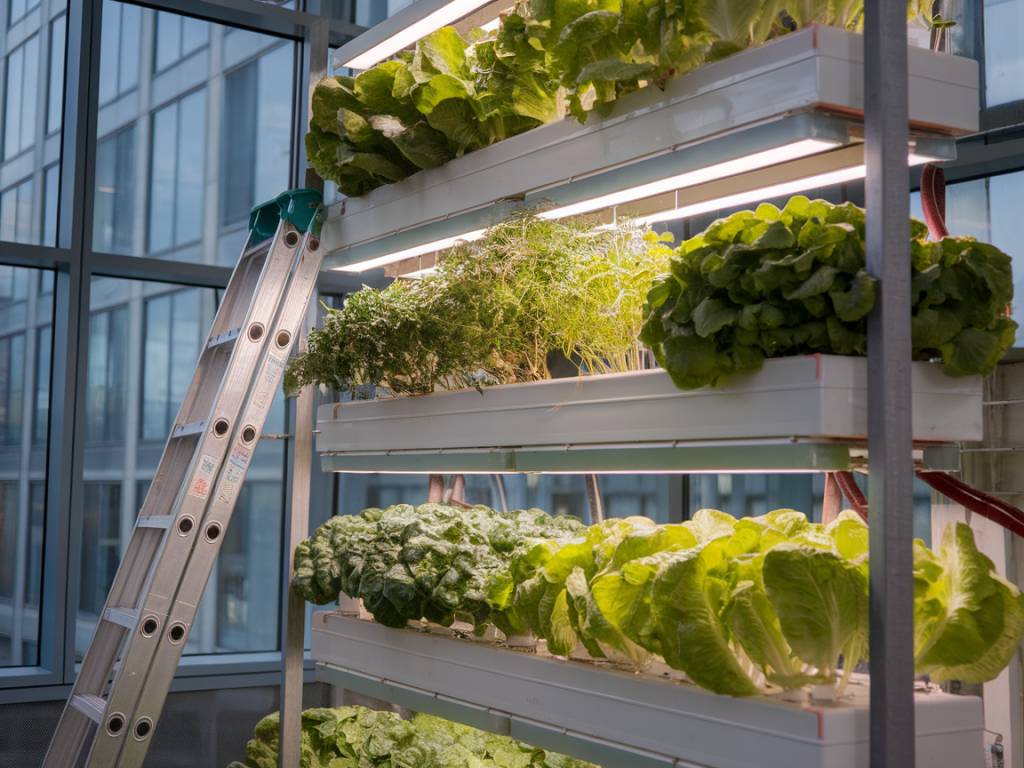The Rise of Vertical Farming in Urban UK
Where do you grow food when space is at a premium, pollution pervades soil, and traditional farming is hundreds of miles away? The answer rising above rooftops in cities like London, Manchester, and Birmingham is vertical farming. This innovative agricultural method uses controlled environments, vertical stacked layers, and often hydroponic or aeroponic systems to grow food where most people live — in cities.
In the UK, where urban land is limited and nearly 84% of the population lives in cities, vertical farming is no longer a futuristic concept — it’s a concrete tool for transforming urban sustainability. As climate pressures intensify and supply chains face increasing fragility, vertical farming represents both a technological step forward and a socially responsible shift in how we think about food systems.
What is Vertical Farming?
At its core, vertical farming involves cultivating plants in vertically stacked layers, often within climate-controlled greenhouses or repurposed urban spaces like disused warehouses or shipping containers. Most models avoid the use of soil altogether, relying instead on hydroponics (nutrient-enriched water), aeroponics (nutrient misting), or aquaponics (a symbiotic fish-plant system).
These systems use LED lighting to mimic natural sunlight, advanced climate control to optimise growth conditions, and sometimes AI-powered sensors to monitor plant health in real time. This efficient, scalable model allows growers to produce fresh food year-round — without pesticides, with minimal water, and miles closer to consumers.
Why Urban UK Needs Vertical Farming
Urban areas across the UK are facing a food challenge. A growing population, pressure on rural agriculture due to unpredictable weather patterns, and reliance on imported produce all contribute to a vulnerable and unsustainable system. Add to this the post-Brexit food distribution changes and the pandemic’s wake-up call on supply chains, and it becomes clear why solutions like vertical farming are gaining traction.
For instance, most of the UK’s salad greens are imported. Leafy greens grown in vertically stacked trays could not only reduce food miles but also ensure freshness that supermarket shelves often fail to deliver. Imagine buying rucola harvested four hours ago — not four days.
Real-World Examples Taking Root
Vertical farming is no longer confined to labs or startups with big promises. It’s happening — and reshaping how cities in the UK approach local food production.
- GrowUp Farms (Kent & London): Operating in urban and peri-urban areas, GrowUp Farms is a prominent example of a working vertical farm using renewable energy and closed-loop water systems. Their brand « Fresh Leaf Co. » now supplies leafy greens to major UK grocery chains with zero pesticides and 94% less water.
- Harvest London: Based in East London, Harvest London grows herbs and salad crops inside warehouse spaces. Their produce goes directly to restaurants and chefs, cutting out complex logistics and carbon-heavy transport.
- Jones Food Company (Scunthorpe): Likely the largest vertical farm in the UK, JFC operates a facility the size of 26 tennis courts. They’re expanding with a second site in Lydney, Gloucestershire, aiming to grow crops equivalent to 1,000 acres of traditional farmland — indoors.
These examples highlight a key trend: scalable, decentralised, and technologically driven agriculture placed next to consumers.
Environmental Impact and Benefits
A common criticism of vertical farming is its energy use. It’s true — growing food indoors requires electricity for lights, climate control, and sensors. But when powered by renewables and measured against traditional systems, the benefits often outweigh the costs, particularly in an urban, carbon-constrained context.
Consider the environmental upsides:
- Water Efficiency: Vertical farming uses up to 95% less water than traditional agriculture. Through closed-loop hydroponic systems, water is recycled, wasted none.
- Land Use: By growing upward rather than outward, these farms sidestep the need for deforestation or soil degradation.
- No Pesticides: With controlled environments come pest-free crops. That means no chemical runoff and a healthier food chain for pollinators and humans alike.
- Reduced Food Miles: Urban vertical farms cut down transport emissions dramatically, especially for lightweight, highly perishable items like herbs and lettuce.
Moreover, because crops are grown in clean environments, post-harvest washing becomes unnecessary — saving water and energy.
Economic and Social Advantages
Vertical farming also opens new economic possibilities. By localising food production, cities can keep more of the value chain within their economies — from technology and data jobs to agritech manufacturing and urban logistics.
It also promotes food security and local resilience. During the early phases of the COVID-19 pandemic, supermarket shelves across the UK emptied quickly. Centrally located vertical farms could minimise future disruptions by providing fresher local alternatives, even during international crises or transport strikes.
And there’s a social value we can’t ignore: education and engagement. Many urban farming initiatives incorporate school visits or offer city dwellers the chance to reconnect with how their food is grown. In cities where food often feels abstract — pre-packaged and plastic-wrapped — vertical farms offer transparency, traceability, and a touchpoint with nature.
Challenges to Overcome
No innovation is without its growing pains. Vertical farming still faces hurdles, particularly around:
- High Startup Costs: Building a facility with lighting, sensors, automation, and water systems isn’t cheap, despite long-term savings and efficiency.
- Energy Demand: While shifting to renewables helps, energy-intensive systems may not be carbon neutral unless rigorously managed.
- Crop Variety: Right now, vertical farming is best suited to leafy greens and herbs. Growing root vegetables, cereals, or fruits at scale remains technologically challenging — though R&D is rapidly moving forward.
Still, these obstacles are being met with ingenuity. Companies are experimenting with biogas generators, solar-integrated farms, and even AI systems that optimise energy down to the minute. As the sector matures, expect the cost per leaf to drop — and the range of viable crops to expand.
What This Means for Sustainable Living in UK Cities
For anyone invested in sustainable urban lifestyles, vertical farming represents more than a novel growing method — it’s a piece of a much larger puzzle. It dovetails with goals around reducing single-use packaging, improving air quality (many vertical farms include carbon capture components), and decentralising essential services.
Imagine picking up a salad mix that was grown three blocks from your home, packed in reusable containers, and delivered by e-cargo bike. That’s not utopia — it’s already happening in places like Hackney and Leeds.
Moreover, vertical farms can integrate into mixed-use developments, rooftops, or even underground car parks. In the UK’s space-constrained cities, this kind of multifunctional land use could be a game changer, allowing residents to live, work, and eat sustainably — with minimal ecological disruption.
Looking Ahead: A Greener Skyline
Could tomorrow’s urban skyline be dotted not just with banks and apartments, but with green towers growing our lunch? The signs are promising. From policy shifts encouraging urban agriculture to private investment and community-led co-farming models, the roots of this innovation are embedding deeper each year.
The challenge — and opportunity — is in scaling responsibly and maintaining transparency. Urban dwellers are already asking tougher questions about food provenance. Vertical farming offers tangible answers while reconnecting cities to the lifeblood beneath their concrete — the food they eat.
And for UK cities teetering on the edge of ecological and logistical limits, that’s not just ambitious — it’s essential.



